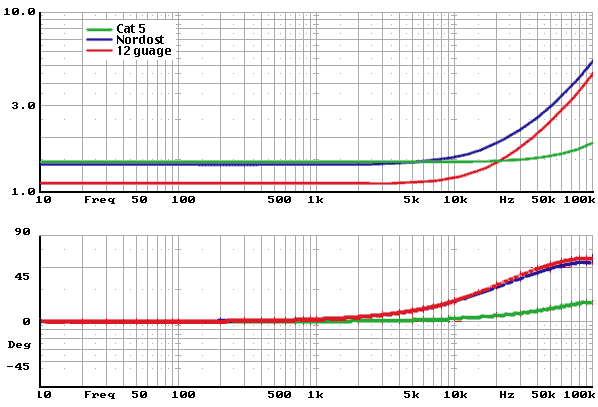| The Drabitt Files 10_dec_2005 Comparison of Impedance & Phase of Cat 5, Nordost, and 12 guage wire by Aaron Drabitt |
|
Listening to some cables (I HEARD a difference (improvement) using Cat 5) prompted me to measure for phase shift on a hunch.
I first measured a 0.22 W wirewound resistor as a baseline and then all the speaker cables using the same 0.22 W resistor as the termination. The reason for the resistor was to raise the measured impedance above the inherent impedance of the test system and swamp any small variances at the nW level. The frequency response of the resistor and all the cables were measured in the same fashion and all show absolutely flat FR. The top graph is the impedance vs frequency. The bottom graph is the phase shift vs frequency. All the plots have been normalized to the impedance & FR of the resistor. (ie the FR plot is the R(cable + the resistor)/R(resistor)) |
|
|
| Obvioustly there is significant
phase shift well within the 20Hz - 20KHz region with both types of speaker cables,
however the Cat5 cable is almost perfectly linear! I think the majority of improvement comes from the added parallel capacitance of the twisted pair using Teflon dielectric which is not present in the Nordost or 12 guage, but built into the Cat 5 to ensure a constant surge impedance of 100 W at 100 MHz. Cat 5 is definitely "wide band". The great thing with the Cat 5 other than the cost, is that it's easy to increase your current carrying capability by just adding more and more pairs. However the two meter four pair was the same resistance as the 3 meter Nordost. |
|
[ <-- Back to the T-Line Speakers | Odds & Ends | Cat 5 ] |
